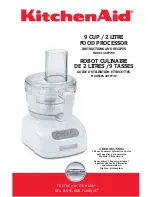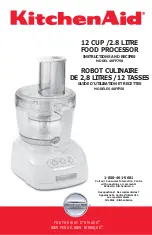
7
To whip cream:
Processor whipped cream holds its shape very well.
It is good for decoration or as a topping for ginger-
bread, berries or other desserts. It will not whip to
the light, fluffy consistency obtained by methods that
beat in more air. Use the optional Whisk Attachment
for the fluffiest whipped cream.
Chill the cream well before starting. Process continu-
ously until it begins to thicken. Then add sugar as
desired and continue processing, watching carefully
until the cream reaches the desired consistency.
For consistently reliable results, add 2 tablespoons
of non-fat dried milk for every cup of cream, before
whipping.
To make crumbs and crumb crusts:
Cut or break bread, crackers or cookies into pieces
and put them in the work bowl. Process continuous-
ly until they reach the desired texture. For seasoned
crumbs, chop the parsley or other fresh herbs with
the crumbs. For buttered crumbs, process until the
dry crumbs are of the desired texture, then drizzle
melted butter through the small feed tube while the
machine is running.
For crumb crusts, process crackers or cookies as
described above. Add sugar, spices and butter, cut
into pieces, as specified by your recipe. Process
until well combined.
To make pastry:
This describes general procedure. A recipe giving
exact proportions is at the back of this book.
Combine unbleached all-purpose flour, salt and
pieces of very cold or frozen butter in the work bowl.
Process to the consistency of cornmeal. While
pulsing, start pouring ice water through the feed
tube. Stop pulsing as soon as the dough begins to
form a ball, to ensure tender, flaky pastry. Use the
dough immediately or form it into a round disc about
1-inch thick. Wrap it in plastic wrap and refrigerate
or freeze for later use.
To make quick breads and cakes that use
baking powder and/or soda:
The most important rule for success is not to over-
mix after the flour is added. If the recipe calls for
chopped ingredients like lemon peel or nuts, chop
them first while the work bowl is clean and dry. Then
set them aside until needed. (Always use sugar when
chopping lemon peel.)
Put dry ingredients like flour, salt and leavening in
the work bowl and process with the metal blade for
5 seconds to mix them. Remove and reserve the
dry ingredients. Add the eggs and sugar to the work
bowl and process to mix, letting the machine run
about 1 minute. Next, add butter, which has been
cut into 1-inch pieces and brought to room tempera-
ture. Let the machine run continuously for a minute,
until the butter is thoroughly mixed with the sugar
and eggs. Then add flavoring and liquid – vanilla,
spices, cocoa, etc. Process until mixed. Add the dry
ingredients to the work bowl. Process by pulsing,
inspecting after each pulse. Stop pulsing as soon
as the dry ingredients have almost disappeared into
the batter.
Overprocessing will cause quick breads and cakes
to be tough. (If your recipe calls for ingredients that
are to be coarsely chopped, like raisins or nuts, add
them last with the mixed dry ingredients.)
To make cake mix:
Your food processor work bowl is large enough for
the preparation of an 18.5-ounce packaged cake
mix.
Insert the metal blade and add the cake mix to the
work bowl. While the machine is running, add the
eggs and liquid through the small feed tube and
process for 5 seconds. Scrape down the side of
the work bowl and process again for 1 minute for
maximum volume. Do not remove the metal blade.
Insert a finger into the underside of the blade from
the bottom of the work bowl to hold the blade in
place while emptying the batter.
Tip: After emptying cake batter or puréed soup from
the work bowl, replace the bowl on the motor base.
Insert the metal blade and pulse once. Centrifugal
force will spin the batter off the blade onto the side
of the work bowl. Remove the blade, and use the
spatula to scrape any remaining batter from the
bowl.
TECHNIQUES FOR KNEADING
YEAST DOUGH
The Classic Series 14-Cup food processor can mix
and knead dough in a fraction of the time it takes
to do it by hand. You will get perfect results every
time if you follow these directions. NEVER TRY TO
PROCESS DOUGH THAT IS TOO STIFF TO KNEAD
COMFORTABLY BY HAND.
There are two general types of yeast dough.
Typical bread dough is made with a flour mix that
contains at least 50% white flour. It is uniformly soft,
pliable and slightly sticky when properly kneaded.
It always cleans the inside of the work bowl com-
pletely when properly kneaded.
Typical sweet dough contains a higher proportion of
sugar, butter and/or eggs than typical bread dough.
It is rich and sticky and it does not clean the inside
of the work bowl. It requires less kneading after the
ingredients are mixed. Although 30 seconds is
usually sufficient, 60 to 90 seconds gives better
results if the machine does not slow down. Except
for kneading, described below, the processing
Содержание DFP-14N Series
Страница 15: ...15 NOTAS...
Страница 16: ...16 SWEET SAVORY RECIPES Appetizers 17 Soups 18 Entr es 20 Side Dishes 23 Salads Sauces 24 Breads 26 Desserts 29...
Страница 49: ...16 NOTAS...








































